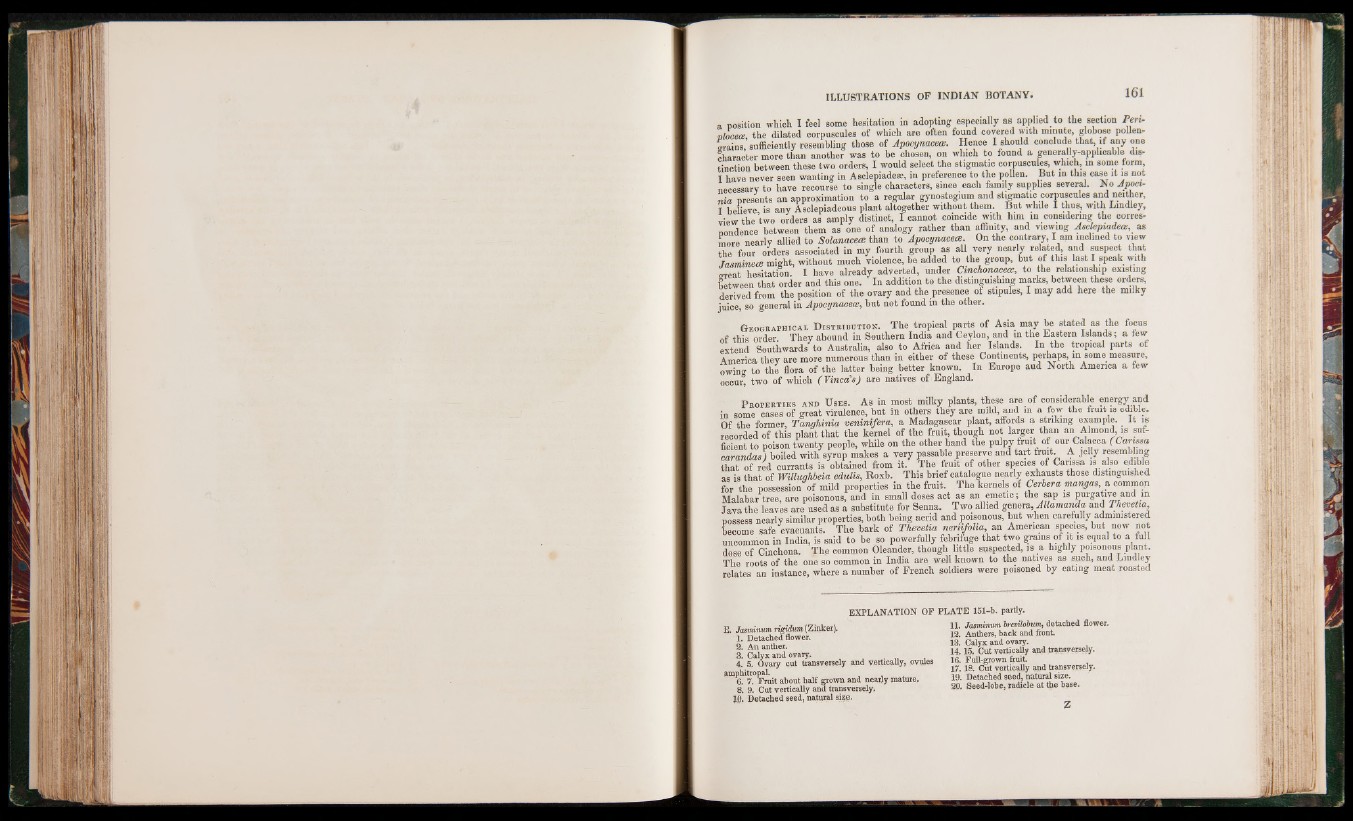
a position which I feel some hesitation in adopting especially as applied to the section Peri-
„loceos, the dilated corpuseules of which are often found covered with minute, globose pollen-
ffrains, sufficiently resembling those of Apocynacece. Hence I should conclude that, if any one
character more than another was to be chosen, on which to found a generally-applicable dis-
Hnction between these two orders, I would select the stigmatic corpuseules, which, in some form,
I have never seen wanting in Asclepiadeae, in preference to the pollen. But m this case it is not
necessary to have recourse to single characters, since each family supplies several. No Apoci-
nia presents an approximation to a regular gynostegium and stigmatic corpuseules and neither,
I believe is any Asclepiadeous plant altogether withont them. But while I thus, with Lmdley,
view the two orders as amply distinct, I cannot coincide with him in considering the corres-
nondence between them as one of analogy rather than affinity, and viewing Asclepiadece, as
more nearly allied to Solanacece than to Apocynacece. On the contrary, I am inclined to view
the four orders associated in my fourth group as all very nearly related, and suspect that
Tasminece might, without much violence, be added to the group, but of this last I speak with
oreat hesitation. I have already adverted, under Cinchonacece, to the relationship existing
between that order and this one. In addition to the distinguishing marks, between these orders,
derived from the position of the ovary and the presence of stipules, I may add here the milky
juice, so general in Apocynacece, but not found in the other.
Geographical Distribution. The tropical parts of Asia may be stated as the focus
of this order. They abound in Southern India and Ceylon, and in the Eastern Islands; a few
extend Southwards to Australia, also to Africa and her Islands. In the tropical parts of
America they are more numerous than in either of these Continents, perhaps, m some measure,
owing to the flora of the latter being better known. In Europe and North America a few
occur, two of which (Vinca's) are natives of England.
P roperties anD Uses. As in most milky plants, these are of considerable energy and
in some cases of great virulence, but in others they are mild, and m a few the fruit is edible.
Of the former, Tanghinia veninifera, a Madagascar plant, affords a striking example.' I t is
recorded of this plant that the kernel of the fruit, though not larger than an Almond, is suf-
ficient to poison twenty people, while on the other hand the pulpy fruit of our Calacca (Canssa
carandas) boiled with syrup makes a very passable preserve and tart fruit. A jelly resembling
that of red currants is obtained from it. The fruit of other species of Canssa is also edible
as is that of Willughbeia edulis, Roxb. This brief catalogue nearly exhausts those distinguished
for the possession of mild properties in the fruit. The kernels of Cerbera mangas a common
Malabar tree, are poisonous, and in small doses act as an emetic; the sap is purgative and in
Java the leaves are used as a substitute for Senna. Two allied genera, Allamanda and Thmetta,
possess nearly similar properties, both being acrid and poisonous, but when carefully administered
become safe evacuants. The bark of Thevetia neriifolia, an American species, but now not
uncommon in India, is said to be so powerfully febrifuge that two grams of it is equal to a full
dose of Cinchona. The common Oleander, though little suspected, is a highly poisonous plant.
The roots of the one so common in India are well known to the natives as snch, and Lmdley
relates an instance, where a number of French soldiers were poisoned by eating meat roasted
EXPLANATION OP PLATE 151-b. partly.
E. Jasminum ngirfum (Zinker).
1. Detached flower.
2. An anther.
3. Calyx and ovary. .
4. 5. Ovary cut transversely and vertically, ovules
amphitropal.
6. 7. Fruit about half grown and nearly mature,
8. 9. Cut vertically and transversely,
JO. Detached seed, natural si?e.
11. Jasminum brevilobum, detached flower.
12. Anthers, back and front
13. Calyx and ovary.
14.15. Cut vertically and transversely.
16. Full-grown fruit
17.18. Cut vertically and transversely.
19. Detached seed, natural size.
20. Seed-lobe, radicle at the base.
Z